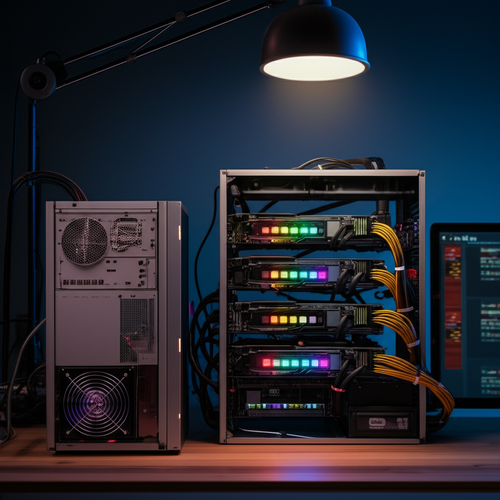Building Efficient Crypto Mining Setups at Home
The allure of cryptocurrency mining from the comfort of one’s home has captivated enthusiasts worldwide. What began as a niche hobby for tech-savvy individuals has evolved into a sophisticated endeavor, demanding careful planning and optimization. Building efficient crypto mining setups at home isn’t just about plugging in hardware; it’s about creating a sustainable, profitable, and often, quiet operation. This guide explores the essential components and strategies for home miners looking to maximize their returns while minimizing common challenges.
The Resurgence of Home Crypto Mining
While large-scale industrial mining operations dominate headlines, home mining continues to thrive, particularly with the availability of more accessible and efficient hardware. The decentralized nature of cryptocurrencies means that individual contributions, no matter how small, are vital to network security and operation. Many choose home mining not just for potential financial gains but also for the satisfaction of participating directly in the blockchain ecosystem.
The broader cryptocurrency market, as seen on platforms like HTX, plays a significant role in dictating the profitability and interest in mining. Price fluctuations directly impact a miner’s revenue, making efficiency and low operational costs paramount. Understanding market trends and choosing the right coins to mine are as crucial as the hardware itself.
Tackling the Mining Challenges: Noise, Heat, and Power
Home mining comes with its unique set of challenges. The powerful hardware required generates considerable heat and noise, and consumes significant electricity. Addressing these issues effectively is key to a successful and harmonious home mining experience.
Noise Reduction Strategies
Modern mining rigs, especially those equipped with Application-Specific Integrated Circuits (ASICs), can be incredibly loud due to their high-speed cooling fans. This noise can be a major deterrent for home miners. Innovative solutions, such as specialized sound-dampening enclosures, have emerged to tackle this problem directly. Companies like Miner Boxes offer purpose-built solutions designed to significantly reduce the acoustic footprint of mining hardware, making it feasible to operate rigs in residential environments without disturbing occupants or neighbors.
Effective Cooling Solutions
Heat is the archenemy of electronic components, and mining hardware generates a lot of it. Proper cooling is not only crucial for the longevity and stability of your equipment but also for maintaining optimal performance. Beyond efficient fan systems, home miners are exploring various cooling methods:
- Airflow Management: Directing hot air away from the miners and ensuring a constant supply of cool ambient air is fundamental. This often involves creating a dedicated space with good ventilation.
- Immersion Cooling: For advanced setups, immersing hardware in non-conductive dielectric fluid offers superior heat dissipation. While more complex, it’s highly effective for densely packed rigs.
- Dedicated Enclosures with Integrated Cooling: Solutions from providers like Miner Boxes often integrate advanced cooling systems, from powerful fans to exhaust ducts, specifically designed to manage the intense thermal output of mining ASICs or GPUs.
Even visual platforms like Ice River EU often showcase creative cooling setups and hardware designs, providing inspiration and practical examples for optimizing thermal management in compact spaces.
Power Efficiency and Hardware Choices
Electricity consumption is typically the largest operating cost for a home miner. Therefore, selecting energy-efficient hardware is paramount. When choosing an ASIC miner or GPU, always compare its hashing power (processing speed) against its power consumption (measured in watts) to determine its efficiency ratio (Joule per Terahash or Megahash). Newer generation hardware tends to be significantly more efficient, often justifying the higher initial investment through lower ongoing electricity bills.
Furthermore, optimizing your power supply unit (PSU) and ensuring clean, stable power delivery can also contribute to overall system efficiency and reliability. Monitoring tools that track power usage in real-time can help identify inefficiencies and opportunities for adjustment.
Optimizing Your Mining Environment
Beyond the hardware and specific solutions, the overall environment where your mining setup is located plays a critical role in its efficiency and longevity.
Strategic Placement and Ventilation
Consider placing your mining setup in an area with good natural airflow, such as a basement, garage, or a dedicated utility room. Avoid enclosed, poorly ventilated spaces like closets, which can quickly overheat. If natural ventilation isn’t sufficient, consider installing exhaust fans or even a small HVAC system to manage temperature and humidity, which can also affect hardware performance and lifespan.
Monitoring and Maintenance
Regular monitoring of your mining hardware’s performance, temperature, and power consumption is essential. Many mining software solutions offer dashboards that provide real-time data. Pay attention to any unusual spikes in temperature or drops in hash rate, which could indicate a problem. Routine maintenance, such as dusting fans and heatsinks, and checking cable connections, can prevent issues before they become serious.
Insights from the Mining Community and Future Trends
Staying informed about the latest developments in the crypto mining space is crucial for sustained success. Resources like the One Miners newsletter often provide valuable insights into market trends, new hardware releases, and best practices shared by experienced miners. Engaging with the community allows home miners to adapt quickly to changing conditions, optimize their strategies, and troubleshoot common issues.
The future of home crypto mining is likely to be shaped by continued advancements in energy efficiency, the development of more compact and quieter hardware, and the increasing adoption of renewable energy sources to power operations. As the world moves towards greener energy solutions, home miners who embrace sustainable practices will find themselves well-positioned for long-term success. Furthermore, regulatory landscapes and technological innovations, such as advancements in proof-of-stake protocols, will continue to evolve, requiring miners to remain agile and well-informed.
Conclusion
Building efficient crypto mining setups at home is a rewarding endeavor that combines technological expertise with strategic planning. By prioritizing noise and heat management, selecting power-efficient hardware, and maintaining an optimized environment, home miners can create sustainable and profitable operations. As the crypto landscape evolves, staying connected with community insights and adapting to future trends will be key to unlocking the full potential of your home mining journey.



